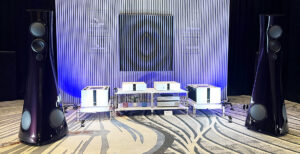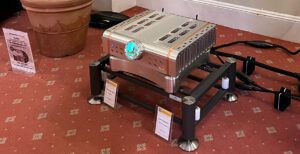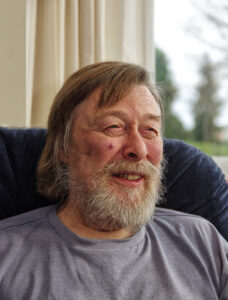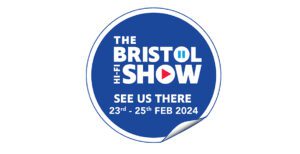
Hi-Fi+ has just returned from T.H.E. Show Newport Beach 2015 and a fine event it proved to be. The setting was lovely – southern California at its finest; the atmosphere was inviting – conveying a delightful ‘created-by-and-for-music-lovers’ vibe; and the range of products on demonstration was impressive and eclectic – with everything from ‘unobtanium-class’ systems on through to value-priced wonders that stunned show-goers with their excellence per dollar (or pound, or euro). No matter where you may live, our wish would be that you might one day have the opportunity to attend this show, simply for the pure joy of it.

As at any show, some Newport rooms sounded very good (and in a few instances, even great), but others decidedly did not. We come, then, to praise the good and decry the, um, not so good.

If I had one complaint about the sound at Newport, it would be that many high-priced systems seemed to be afflicted with thin, bright, strained, fingernails-scraping-on-a-chalkboard-grade upper midrange and treble problems. Thankfully, this wasn’t a universal problem, but it is one that hampered the sound quality of more than a few otherwise good systems. The part I found troubling was that manufacturers and show-goers alike seemed willing to overlook or ignore obvious sonic problems that were pretty much setting my teeth on edge. My thought: we’re supposed to be the best in the business, so surely we can do better than this…

Ah, but on the other side of the ledger, I heard a number of systems that seemed to maximise the potential of the equipment in play, and—in a number of instances—to find the magic in the music. At the end of the day, we really can ask no more than that. Below, I’ve highlighted fifteen systems that caught my ear as offering exceptional sonic merit. But please note: I’m not saying that these were the only great systems on hand (it’s impossible, after all, for one person to take in all that Newport has to offer no matter how hard one might try). But I am saying these fifteen brought some very special things to the musical ‘party’ that is T.H.E. Show Newport.
Note: In each of the systems below, I list the speaker manufacturer first, then the electronics manufacturer, and then the ancillary component and cable manufacturers, where known.
Burmester – Metronome – Torus Power – MIT
One Burmester demonstration, as put on by the local dealer Tweak Studio, featured the firm’s compact and quite innocent-looking B25 floorstanders, as fed by a mix of Burmester analogue and digital source components, with power supplied by a mighty Burmester 911 Mk3 power amplifier. As heard during show hours, the system produced a very fine, albeit traditional ‘hi-fi’ sound, but as heard after show hours the magic really began to unfold. From the outset, the relatively compact B25 speakers sounded larger and more capable than they at first appeared, but after a bit of judicious tweaking things got even better.

First, the Tweak Studio inserted a Torus Power isolation transformer upstream of the system’s Burmester power conditioner, with sonic effects that far exceeded my expectations (yielding a considerably bigger soundstage, more effortless 3D imaging, and – surprisingly – richer tonalities overall). It’s enlightening to hear how one well-chosen tuning change can unlock whole layers of previously untapped potential.
Acting on the same impulse to, well, gild lilies that really don’t need much gilding, the Tweak Studio then decided to substitute a very exotic Metronome Technologie Calypso CD transport and C6 Signature DAC for the entry-level Burmester CD player and DAC that had been in the system initially. Taken in isolation, I would have said the entry-level (note: ‘entry level’ is always a relative term in Burmester-land) Burmester front-end had been very, very good, but the über-expensive Metronome package was even better. The result, in the end, was a relatively compact system that no longer sounded like one, instead producing a big, expansive, expressive, and dynamically powerful sound.
ELAC America – Bel Canto
In one of the worst-kept secrets in audio, the famed British loudspeaker designer/technologist Andrew Jones earlier this year made a transition from TAD to ELAC, and the Newport show gave us our first opportunity to hear what Jones has created in the few short months he has been working with the German firm. Specifically, ELAC and Jones were showing a new value-priced line of speakers and subwoofers collectively known as the Debut series. For the firm’s primary demonstration, ELAC showed its entry-level Debut B5 stand-mount monitors that sell for – no, this is not a typo – an oh-so-modest $229/pair. For the demonstration, the speakers were shown on generic albeit sand-filled stands priced at $50/pair and were powered by a good but not terribly high-priced Bel Canto integrated amplifier/DAC.

The sound. Well, the sound was gob smacking, jaw dropping, mind-bending, and a bunch of other superlatives; the sound was so very good, in fact, that it went far, far beyond what one might reasonably have expected for the price. In fact, if heard behind a sonically transparent but optically opaque scrim, I suspect most listeners would have guessed the speaker’ price to be at least 10X higher than it actually is. Not surprisingly, Jones and his little ELACs became the ‘buzz’ of the show, since almost all who heard them immediately grasped that Jones and ELAC may well have recalibrated our notions of what ‘value-priced high-performance audio’ can do and be. Finally, we have a genuinely inexpensive loudspeaker that not only sounds good ‘for the money’, but sounds genuinely good, full stop.


Focal – Naim
There are times when manufacturers just want to pull out all the stops to see what their companies are capable of doing. Once such moment involved the Focal Stella Utopia speaker demonstration as powered by the cost-no-object Naim Statement electronics suite. The results were impressive indeed. I must confess that I have enjoyed hearing upper tier Naim and Focal components in isolation from one another, but had never heard them together, and coming in to this demonstrations I had some questions about whether the characteristic ‘house sounds’ of one brand would marry well with the other.

As it turns out, I needn’t have worried. The Focal/Naim demo at Newport convinced me, and many others I suspect, that there are significant synergies to be had, with the dynamicism, impact, transient speed, and life of the Naim components enlivening the powerful, balanced, suave, and nuanced sound of the Focals.

Gamut – Pear Audio Blue
One of the most deeply moving systems I heard at Newport, and one whose magical sound stuck in mind throughout the show and beyond, was a system comprised of GamuT’s new-generation RS3 stand-mount monitors, Gamut electronics (the D200i power amp and D3i preamp), analogue components from Pear Audio Blue (the Kid Thomas turntable, Cornet 2 tonearm, power supply, and Reference 2-box phono stage), an Ortofon Cadenza Bronze phono cartridge, and GamuT cables. What gripped me about the system was its ability to sidestep hi-fi conventions and to defy traditional tick-box assessment of sonic parameters, instead ushering listeners straight into the presence of the music itself.

Candidly, I have heard GamuT’s earlier generation RS-series speakers and have found them technically impressive, with a notably clean, precise, and almost pluperfect purity of presentation, yet when it came to the question of musical soulfulness or expressiveness I found the earlier models less than fully engaging. All of that, however, is changed thanks to the input of designer Benno Baun Meldgaard. Meldgaard worked hard to preserve the many things that were already right about GamuT speakers while assiduously tracking down those elusive factors that spell the musical difference between good hi-fi and the magic of great music. My take: Mr Meldgaard has succeeded in brilliant fashion.

A special mention must also be made of the contribution from Pear Audio Blue turntable, tonearm, and phono stage – all of which take as their points of departure the design concepts put forward by the late Tom Fletcher of Nottingham Analogue Systems fame. In a very real sense, Pear is striving to produce the turntables Fletcher himself might have created had he survived and the proof lies in the effortlessly musical sound these components deliver.
Magico – Soulution – Berkeley – Acoustic Signature – Sonorous – Synergistic Research
One of the best sounding demonstration systems at Newport was the one assembled by Scott Walker Audio with a little (OK, a lot) of help from the experts at Magico, Soulution, Acoustic Signature, and Synergistic Research. The room had superb basic ingredients including Magico S5 loudspeakers, a Soulution 725 preamp and 711 power amp, a Berkeley Alpha DAC Reference, an Acoustic Signature Challenger III turntable with SME 309 tonearm and Lyra Skala cartridge, and a Sonorous Audio ART 12 Reference reel-to-reel tape deck, but what really tied all of the pieces together were the various room tuning components and cable systems from Synergistic Research.
What sort of room tuning components are we talking about? Synergistic brought along roughly 150 of its tiny HFT-type (High Frequency Transducer) tuning devices, one of its Black Box LF (low frequency) stabilizers, and a pair of its unorthodox, not-in-the-signal-path, RF-range Atmosphere Acoustic Wave Generators (though the Atmospheres are not transducers at all in the sense that, say, a loudspeaker is). Most of the HFT devices were positioned on the walls and ceiling of the demonstration room, while a few were placed directly on the front, sides, and backs of the Magico speakers. The Black Box was on the floor between the speakers, and the Atmospheres were positioned such that one was in the back-centre of the room and the other elsewhere in the room.

In A/B comparisons between the system with the Synergistic components in place vs. the system with some of the Synergistic devices removed or disengaged immediate and important sonic differences could be heard. Without the tuning components one heard excellent – truly excellent – hi-fi of the first rank, but with the tuning components in play the music simply broke free from the usual hi-fi constraints, taking on a vibrant, three-dimensional life of its own. What was particularly impressive was the fact that the HFT devices helped the already excellent Magico speakers shift gears, so to speak, to tap even higher levels of performance. The Atmosphere device, in turn, enabled the music to break free from the speakers and to scale to fit the size of the very large room, thus producing wall-to-wall soundstages of exceptional width and depth.
The result, as I have hinted above, was a system that seemed to have broken free from traditional hi-fi ‘shackles’, in the process it set the music free to communicate with listeners on a more direct, intimate, and visceral level.
Magnepan – Bryston – Oppo; Magnepan – Moon by Simaudio – JL Audio
Wendell Diller and the Magnepan team conspired, with a good bit of help from the team at Shelley’s Stereo, to set up a friendly ‘intramural competition’ between two differently configured Magnepan systems set up in two demonstration rooms, both of which featured the firm’s .7 floorstanding quasi-ribbon-type loudspeakers.

The Magnepan room featured a three-channel (or as Magnepan sometimes puts it, a ‘Tri-Centre’) system comprising three .7 loudspeakers driven by Bryston power amplifiers, a Bryston surround-sound A/V controller, and fed by an Oppo universal Blu-ray/player. The Shelley’s room featured a stereo .7 system driven by Moon by Simaudio components and supported by two next generation JL Audio subwoofers.

Of the two systems, I personally preferred Magnepan’s own system, in part because I favoured the pure, full-range sound of the .7s to the sound of the dipole speakers supplemented by subwoofers (even under the very best of circumstances, I have found the Maggies to be notoriously difficult to match seamlessly with subwoofers).
Either way, though, Magnepan’s .7 loudspeakers proved you don’t have to spend an arm and a leg to achieve a big, expansive, refined, and room-filling sound.
MBL North America – United Home Audio
Jeremy Bryan and the team at MBL North America almost always put on a good demonstration and the MBL room at Newport 2015 proved to be no exception. The system featured a pair of MBL 101E MkII loudspeakers fed by MBL’s 6010D ‘Vorverstarker’ preamplifier and a quartet of giant MBL 9011 monoblock amplifiers, with a United Home Audio reel-to-reel tape deck serving as the primary source component.

The term ‘blockbuster sound’ was probably coined with just such a system in mind, as the MBL rig proved fully capable of playing tapes of rock material at – or even beyond – rock concert volume levels (though it is a matter of debate as to whether such extreme levels are actually enjoyable or even safe from a hearing health perspective). As always, the big Radialstrahler–type loudspeakers produced enormously spacious soundstages, quite good imaging (something not all omnidirectional loudspeakers can do), and a sound that freed listeners from the need to seek out a particular ‘sweet spot’ centred between the speakers (the MBLs work well for virtually any listening position in the room).

__________
This concludes Part 1 of this article.
By Chris Martens
More articles from this authorRead Next From Blog
See all
AXPONA 2024 Show Report Part One
- Apr 19, 2024

Audio Show Deluxe 2024: A photo show report
- Mar 28, 2024

Paul Messenger 1949-2024: A personal tribute
- Mar 26, 2024

Bristol Hi-Fi Show 2024: See You There!
- Feb 21, 2024










